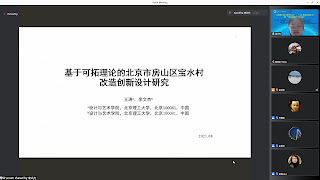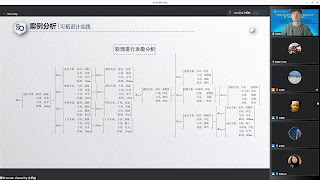The 17th Extenics Annual Meeting、Artificial Intelligence
Frontier Forum and Extension Innovation Method Training Course ("全国第17 届可拓学年会"、"人工智能前沿论坛"暨"可拓创新方法培训班") were organized by Chinese
Association for Artificial Intelligence (CAAI) (中国人工智能学会) and Extenics Professional
Committee of CAAI (中国人工智能学会可拓学专业委员会) from 12th to 15th Aug 2021.
The first day is mainly for keynotes reporting and second day for AI frontier
forum in the morning and sharing session in the afternoon, as well as, closing
at the end. On Day 2 afternoon, there
were two parallel sharing session.
Sharing Session I
The first speaker was Mr. Tong Xiaodong and his topic
entitled “Intelligent Fitting Model of Emotional Basic-Element” (仝小冬、尚会超 - 情感化造型基元的智能拟合模型).
Mr. Tong used Kansei Engineering and Extenics for designing
the disposable trocar for laparoscopy (一次性腹腔鏡用穿刺器).
The second speaker was Prof. Sun Baiqing and his presentation
named “Extension Modeling and Application of Key Contradiction Problems in the
Field of Performance Evaluation” (孙佰清、所蕾、经纬 - 绩效评价领域的关键核心矛盾问题的可拓建模及其应用).
Prof. Sun briefed the performance evalution model 4E
(Economic, Efficiency, Effectiveness and Equity) in the beginning, and then he
combined with balance scorecard and extension transformation into the
performance evaluation model.
The third speaker was Ms. Zhao Baolin and her topic was “Research
on risk management of automobile after-sales service based on extension model”
(赵宝琳、苏越良 - 基于可拓模型的汽车售后服务风险管理研究).
Ms. Zhao analyzed the risk factor using extension model and
evaluating it quantitatively.
The fourth speaker was Ms. Li Wenjie and her presentation title
named “Research on the Innovative Design of Baoshui Village Reconstruction in
Fangshan District, Beijing based on Extension Theory” (王涛、李文杰 - 基于可拓理论的北京市房山区宝水村改造创新设计研究).
Ms. Li demonstrated using extension innovation method for
solving antithetical problem on the village reconstruction design.
The fifth speaker was Mr. Xu Fengkui and his presentation
entitled “The Interior Design of Driverless Car based on Extension Theory” (王体春、许枫魁 - 基于可拓理论的无人驾驶汽车内饰设计).
Mr. Xu employed Conjugate Analysis and extended to different
soft part ideas so as to get the optimized design solution.
Dr. Lotto Lai was the sixth speaker and his topic named “A Preliminary Study on the Analysis of Sun Tzu's Art of War by Extenics” (黎剑虹 - 用可拓学分析孙子兵法的初探). Firstly, I briefed the background
of foreign study in the Art of War and then tried to model the theory using
basic-element.
The leader’s estimation formula based on the Art of War was
demonstrated and other items were also modeled.
Finally, some applications were proposed including HR talent
evaluation, company success rate evaluation and startup product and marketing
strategy generation.
The seventh speaker was Ms. Guo Jiayong and her presentation
title was “Extension Psychology and Counseling based on Extenics”. (郭嘉咏、黄可仪、皮海滨 - 基于可拓学的可拓心理学与咨询).
Ms. Guo introduced the Extension Psychology to help patient
solving contradiction psychological problems.
The last speaker in the sharing session I was Ms. Gao Hong and
her presentation title named “Extension Method of Proof of Lower Bound of
Domination Number in Graph Theory” (高红、郭媛媛、刘行、刘巍 - 图论中控制数下界的可拓证明方法).
She demonstrated extension innovation method to solve
military protection strategy problem.
Sharing Session II
The first speaker in sharing session II was Mr. Zhan Min and
his topic entitled “Optimization of Change Propagation Path based on Product
Parameter Basic-element Network” (赵燕伟、詹敏、任设东、汪磊 - 基于产品参数基元网络的变更传播路径优化).
Then Mr. Zhan demonstrated their basic-element model for the
optimization of propagation path.
The second speaker was Ms. Wang Feng and her presentation
title named “Research on ultra-short-term wind power forecasting based on
extensional representation of environmental characteristics” (王凤、蒋甲丁、张玲玲 - 基于环境特征可拓表示的超短期风电功率预测研究).
Ms. Wang employed matter-element to build the model and then
used comparison algorithm including SVM, Decision Tree, Random Forest, DL, etc.
to predict the wind power.
The third speaker was Mr. Pi Haibin and his topic was
“Application Research on the Integration of Brainstorming and Extension
Innovation Method” (皮海滨、李兴森、王昊 - 头脑风暴法与可拓创新方法集成应用研究).
Mr. Pi based on the insufficient of brainstorming and
integrated extension innovation method to enhance the whole process.
The fourth speaker was Ms. Ding Yurong and her presentation
named “Overview of Data Pricing Application and Future Technology Prospects” (丁玉荣、张钰奇、田英杰 - 数据定价应用综述与未来技术展望).
Ms. Ding explained model based pricing on quality, quatity
and time.
The fifth speaker was Prof. Tian Yingjie (for Ms. Liu Dalian)
and his topic entitled “Analysis of the Characteristics of Multi-model College
Students' Achievements Based on Extension Data Mining” (刘大莲、汤龙、田英杰、李兴森 - 基于可拓数据挖掘的多模型高校学生成绩特点分析).
Finally, Prof. Tian
presented the result of extension cluster on students’ achievement.
The sixth speaker was Mr. Guo Hengfa and his topic was “The Shelf
Structure Design of Automated 3D Warehouse based on Extension Innovation Method”
(郭恒发、李兴森 - 基于可拓创新方法的自动化立体仓库的货架结构设计).
Mr. Guo discussed the extension model for the warehouse and
studied its active transformation and conductive transformation.
The seventh speaker was Mr. Ge Biaobiao and his presentation
title named “Research on Extension Knowledge Representation of Geometric
Effects” (葛标标、杨春燕 - 几何效应的可拓知识表示研究).
Mr. Ge demonstrated some geometric product parts using extension
model to present its characteristics.
The last speaker was Mr. Wu Jiajian and his presentation
topic entitled “Research on Extension Flow Model under TRIZ Flow Analysis” (吴嘉健、杨春燕 - TRIZ 中流分析的可拓流模型建立方法研究).
Mr. Wu showed the extension flow model in which employed
implication relationship.
Closing
Prof. Yang Guowei (杨国为) chaired the closing session.







































沒有留言:
發佈留言